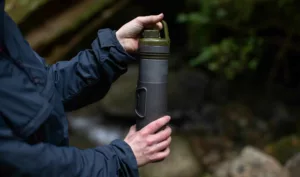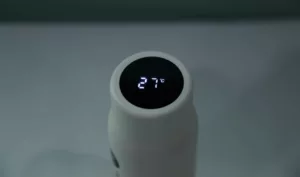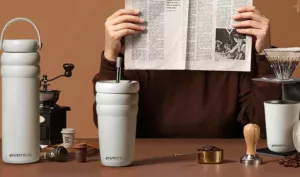Water bottles are ubiquitous in our daily routines, accompanying us on hikes, at the gym, and even during work. However, with the abundance of options available, selecting the right water bottle can feel overwhelming. But fear not! This comprehensive buying guide is here to assist you in navigating through the myriad of choices and discovering the ideal water bottle to suit your needs. From lightweight and collapsible options that are effortlessly portable to insulated bottles that maintain your beverage’s temperature for hours – rest assured, there’s a water bottle for everyone! We’ll explore the advantages and disadvantages of each type, offering tips on selecting based on factors such as durability, portability, and eco-friendliness. Whether you’re an intrepid outdoor enthusiast in need of rugged reliability or an eco-conscious individual, this guide has you covered! Let’s embark on a journey into the realm of water bottles together and find the perfect companion for your next adventure!
What Types of Water Bottles Are Available on the Market?
When considering water bottles, the choices are vast, featuring four main contenders: stainless steel, glass, aluminum, and plastic. Perhaps you seek a bottle that maintains your drinks refreshingly cold or wonderfully hot. Alternatively, you may desire a durable bottle capable of enduring any adventure, or one that captures attention with its distinctive allure. Each material boasts its own advantages and drawbacks, empowering you to delve into the possibilities and prioritize the features that best suit your lifestyle. Embark on the exhilarating journey to discover your ideal water bottle companion!
Glass Cup
Among all types of cups, glass cups are relatively safe. Glass water cups are usually made from inorganic silicate heated to over 600 degrees Celsius, and due to their relatively stable chemical composition, harmful substances are not produced during the manufacturing process. The surface of the glass is smooth, easy to clean, and bacteria and dirt are not easily bred on the cup walls.
It is important to note that when using a glass cup for the first time, do not pour hot water directly into it to avoid bursting due to overheating. The correct approach is to first pour a small amount of hot water, gently shake to preheat the cup, and then pour in the hot water for use.
Ceramic Cup
Ceramic cups, with their beautiful designs and rich patterns, are beloved by young people, and almost everyone has more than one. Ceramic cups can be roughly divided into three categories:
Ceramic cups with no colored glaze and colorless inner walls
The main raw material for these cups is clay, and after high-temperature firing, a glaze will form on the surface of the clay. Usually, this glaze does not contain harmful substances and is suitable for holding hot water or tea.
Ceramic cups with underglaze colors
These cups are colored before firing, and then fired at high temperatures, with the color material located under the glaze surface. Even when brewing hot water, they do not release harmful substances, making them relatively healthier and more environmentally friendly.
Ceramic cups with overglaze colors
In the production process of these products, the pigment is directly applied to the glaze surface and then dried by baking. Unfortunately, during use, these pigments may release harmful substances, posing a threat to health. Therefore, it is recommended to avoid using this type of cup.
Stainless Steel Water Bottle
The stainless steel insulated cup is used for storing hot and cold water, beverages, and other liquids (foods), featuring thermal insulation. The cup body (bottle body, pot body) is made of stainless steel material and processed into a vacuum vessel, also known as a stainless steel vacuum cup. The design principle of the stainless steel insulated cup originates from a chemical experiment apparatus called the “Dewar flask,” which was invented by Scottish chemist and physicist Sir James Dewar in 1892. He used double-layered glass, filled with mercury on the inner wall, and evacuated the air between the two layers to create a vacuum, which was used to store liquid oxygen, achieving excellent low-temperature constant temperature effects. The design of the stainless steel insulated cup utilizes the principle of vacuum layering inside and outside, eliminating heat transfer and convective heat transfer, forming a container with an outer shell and an inner liner made of double-layer stainless steel metal by welding, and then evacuating the middle sealing zone into a vacuum state. In simple terms, the higher the vacuum level, the more stable the thermal insulation effect.
Aluminum Water Bottle
The aluminum sports water bottle is stylish in appearance, lightweight, and conducts heat quickly, making it suitable for room temperature water. However, whether the inner coating of the aluminum water bottle is resistant to corrosion and peeling is a crucial point, as excessive intake of aluminum elements can be harmful to the human body.
It’s safe and poses no health threat. This applies to aluminum water bottles, too. The CDC states that aluminum is not harmful, making it a good alternative to even BPA-free plastic water bottles, and especially so against plastic water bottles that have BPA.
Plastic Water Bottle
In fact, plastics come in various classifications, with different types of plastics having their own functions and flaws. Plastic products (such as water bottles) typically have plastic material labels on the body or bottom of the container. Therefore, when we want to determine if our plastic water bottle is safe, we can do so by checking these labels.
PET (Polyethylene Terephthalate) is commonly used in mineral water bottles, beverage bottles, as well as plastic cups used in coffee and milk tea shops. It can only withstand a maximum temperature of 70℃, so pouring boiling water into it will cause deformation, and repeated use will harm health.
HDPE (High-Density Polyethylene), such as shower gel bottles, shampoo bottles, and other cleaning and bathing products, are made from this material. This type of material cannot be heated either, as it will also deform in high-temperature environments.
PVC (Polyvinyl Chloride) can be used to make plastic water pipes, raincoats, and other items, but it cannot be used to package food, and it releases harmful substances in high-temperature environments.
PE (Low-Density Polyethylene) is commonly used in kitchen cling film, which also has a weak heat resistance. Harmful substances produced at high temperatures can lead to serious conditions such as breast cancer or congenital diseases in newborns. Therefore, when heating food in the microwave, remember to remove the cling film from the food.
PP (Polypropylene) is a type of material that is heat-resistant and does not contain the toxic substance bisphenol A (BPA), making it a relatively safe food-grade plastic. It can also be used to heat food in the microwave.
PS (Polystyrene) is often used in fast food boxes, instant noodle boxes, etc., and has some heat resistance. However, it is still not suitable for heating in the microwave, and it should not be used to contain strong acidic or alkaline foods, as both practices can cause it to release harmful substances.
OTHER (Refers to PC type) PC plastic products are very common in daily life, and many plastic water bottles are made of PC. Under frequent high-temperature use, it will also release the toxic substance bisphenol A, so it should not be heated frequently and should be avoided from direct sunlight, especially in summer.
Tritan (Modified PVC) is currently popular in water bottles on the market. It has the advantage of being heat-resistant and free from bisphenol A, so it can be safely used for microwave heating.
PPSU (Polyphenylsulfone Resin) PPSU is the most stable and heat-resistant material, widely used in the production of baby bottles, making it the best plastic material.
What Are the Advantages and Disadvantages of Different Water Bottles?
Stainless Steel Water Bottles:
Advantages:
Durable and long-lasting.
Resistant to corrosion and rust.
Retains temperature for extended periods.
Generally safe for hot and cold beverages.
Disadvantages:
Can be heavier compared to other materials.
May have a metallic taste, especially when used for hot beverages.
Glass Water Bottles:
Advantages:
Provides a clean and pure taste.
Environmentally friendly and recyclable.
Does not retain odors or flavors.
Disadvantages:
Fragile and prone to breaking.
Heavier than plastic or stainless steel.
Not as effective at maintaining temperature.
Aluminum Water Bottles:
Advantages:
Lightweight and easy to carry.
Good thermal conductivity, keeping drinks cold for longer.
Recyclable and environmentally friendly.
Disadvantages:
Can impart a metallic taste, especially if not coated.
Not suitable for acidic beverages.
May dent or deform if dropped.
Plastic Water Bottles (BPA-Free):
Advantages:
Lightweight and affordable.
Available in various shapes, sizes, and colors.
Less likely to break than glass or aluminum.
Disadvantages:
Environmental concerns due to plastic waste.
May contain harmful chemicals if not BPA-free.
Can retain odors and flavors over time.
Each type of water bottle has its own set of pros and cons, so it’s essential to consider your specific needs and preferences when choosing the right one for you.




